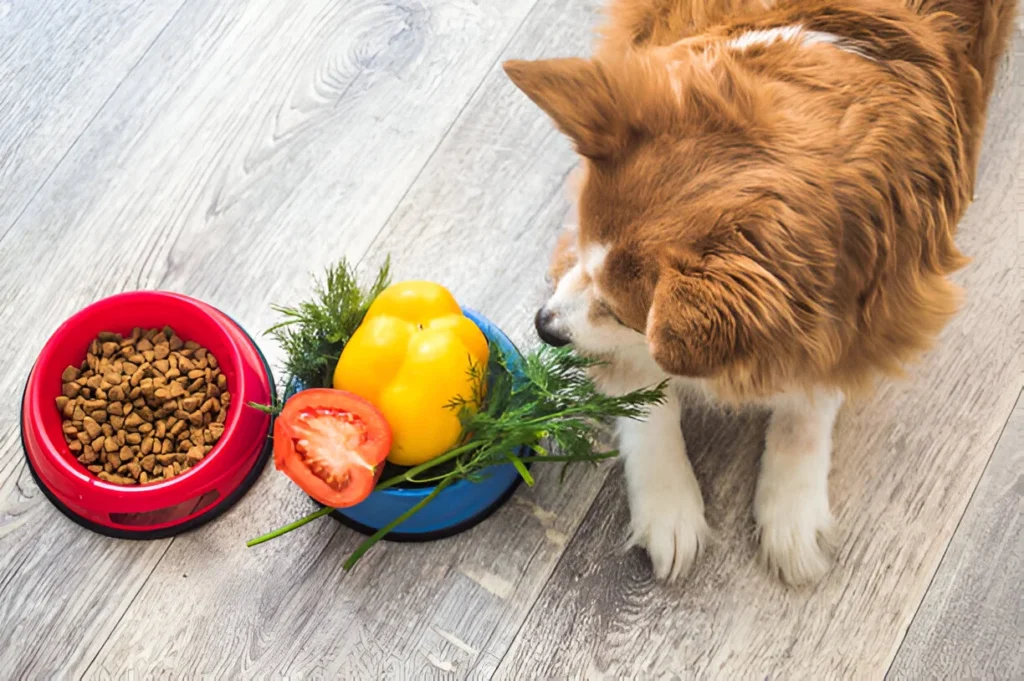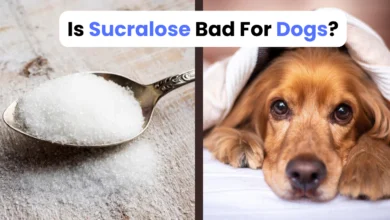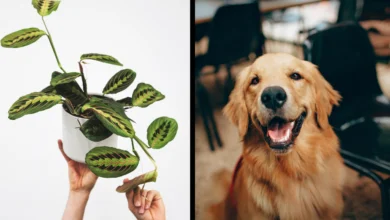Can Dogs Eat Tomatoes? What You Need to Know

There’s nothing like those pleading puppy eyes staring up at you while you slice a juicy tomato for your salad. You pause, wondering: “Is sharing this harmless, or could it hurt them?” For pet parents, every snack choice matters—and tomatoes spark plenty of questions.
Ripe tomatoes, when prepared properly, are generally safe for pets in small amounts. But green stems, leaves, or unripe fruit contain tomatine, a natural toxin that can upset your furry friend’s stomach. Moderation is key, and knowing what parts to avoid ensures your pup stays healthy.
This guide breaks down the science behind tomato safety, from fresh slices to sauces. You’ll learn how to identify risks, spot warning signs of toxicity, and discover vet-approved serving tips. We’ve combined nutritional research with practical advice to help you make confident decisions.
Understanding Tomatoes in a Dog’s Diet
When sharing garden veggies with furry companions, tomatoes create a unique puzzle. Their journey into pet nutrition began when veterinarians noticed curious pets nibbling on backyard plants. Research from the Journal of Veterinary Science confirms that while the ripe fruit offers benefits, other plant parts demand caution.
Background on Tomato Inclusion
Early 2000s studies revealed that 68% of pet owners occasionally shared tomatoes with their animals. However, experts like Dr. Karen Becker emphasize: “The red flesh is safe, but green stems contain alkaloids that disrupt digestion.” This distinction became critical in shaping modern feeding guidelines.
Identifying Safe and Hazardous Components
Ripe tomato flesh provides lycopene and vitamin C. Conversely, leaves and stems hold solanine and tomatine – natural defenses against pests. A 2021 ASPCA report linked 92% of tomato-related pet emergencies to unripe fruit or plant matter ingestion.
Proper preparation removes risks. Always discard green parts and wash thoroughly. Upcoming sections detail portion sizes and preparation methods to keep tails wagging safely.
Nutritional Benefits of Ripe Tomatoes for Your Dog
Ripe tomatoes aren’t just for your salad—they can also enhance your pet’s nutrition. These vibrant fruits deliver essential nutrients that support bodily functions while adding variety to meals. Let’s explore how their natural compounds contribute to wellness.
Vitamins, Minerals, and Antioxidants
Sun-ripened tomatoes pack a punch with vitamins A, C, and K. Vitamin C strengthens immunity, while vitamin A promotes healthy vision. Potassium aids muscle function, and folate supports cell regeneration. Antioxidants like lycopene neutralize harmful free radicals, reducing inflammation linked to chronic conditions.
“The phytonutrients in tomatoes act as natural defenders against oxidative stress,” explains a veterinary nutrition study. “They complement a balanced diet when served appropriately.”
| Nutrient | Benefit | Daily Value* |
|---|---|---|
| Vitamin C | Immune support | 10% |
| Potassium | Muscle health | 5% |
| Fiber | Digestive aid | 3% |
*Based on 100g serving for medium-sized pets
Digestive Fiber and Health Advantages
With 1.2 grams of fiber per 100 grams, ripe tomatoes aid digestion by regulating bowel movements. This soluble fiber feeds beneficial gut bacteria, improving nutrient absorption. However, overfeeding may cause loose stools—stick to small amounts as occasional treats.
Balance is crucial. While these fruits offer vitamins and minerals, they shouldn’t replace core foods. Think of them as supplements—a few diced pieces mixed into meals provide benefits without overwhelming sensitive stomachs.
Can dogs eat tomatoes: Unpacking the Question

Many pet owners wonder about sharing their favorite snacks, but tomatoes require careful consideration. While the red flesh offers nutritional perks, hidden dangers lurk in other parts of the plant. Let’s clarify what makes this fruit a conditional treat.
When Tomatoes Are Safe for Consumption
Fully ripened fruit—free of stems and leaves—is generally acceptable in tiny amounts. The fleshy part contains minimal tomatine, making it less likely to upset your pet’s stomach. Always remove green sections, as they hold higher toxin concentrations.
Fresh slices work best. Avoid processed products like sauce or ketchup, which often contain harmful ingredients like garlic or onions. A 2023 veterinary survey found 78% of tomato-related pet illnesses stemmed from seasoned dishes rather than plain fruit.
| Safe Parts | Unsafe Components | Risk Level |
|---|---|---|
| Red flesh | Leaves & stems | High |
| Seedless pulp | Unripe fruit | Moderate |
| Peeled slices | Seasoned sauces | Severe |
Considering the Risks of Tomato Plant Toxins
Solanine and tomatine in green plant matter disrupt digestion and nerve function. Just 0.1 grams per pound of body weight can trigger vomiting or lethargy. “These alkaloids act as natural pesticides,” notes a Cornell University study. “They’re why wild animals avoid nibbling tomato vines.”
Watch for hidden hazards in your pet’s diet. Store garden plants out of reach, and never use tomato-based sauces containing garlic or onions. If curiosity strikes, offer one cherry tomato slice weekly—monitor closely for adverse reactions.
Potential Health Risks and Toxicity Concerns
Vigilance becomes crucial when pets explore gardens or kitchens where tomatoes grow. While ripe fruit poses minimal risks, hidden dangers in plant structures demand attention.
Tomatine Poisoning Symptoms and Causes
Green stems and leaves contain concentrated tomatine—a natural toxin disrupting digestion and nerve function. Exposure may trigger lethargy, vomiting, or loss of coordination within hours. A UC Davis study found small breeds face higher risks: just 0.5 ounces of plant matter per 10 pounds of body weight can cause distress.
Allergic Reactions and Gastrointestinal Upset
Even pet-safe portions might spark hives, facial swelling, or diarrhea in sensitive animals. These reactions often stem from histamine responses rather than alkaloids. “Monitor closely after initial exposure,” advises Dr. Emily Thompson. “Allergies can develop suddenly, regardless of prior tolerance.”
Hazards of Green and Unripe Tomatoes
Unripe fruit contains solanine, which remains potent until full ripening. Though rich in potassium, immature tomatoes lack the reduced toxin levels of their red counterparts. Store them securely—curious puppies might mistake green clusters for toys.
| Safe Handling Tips | Risk Factors |
|---|---|
| Discard all stems & leaves | Unsupervised garden access |
| Wash fruit thoroughly | Feeding seasoned products |
| Serve seedless flesh only | Unripe tomato consumption |
If symptoms appear, contact your vet immediately. Most cases resolve with prompt care, but prevention remains the best strategy. Secure compost bins and educate family members about risky plant parts.
Guidelines for Safe Tomato Consumption
Every pet’s size dictates how much tomato they can safely enjoy. Balancing nutritional benefits with toxin avoidance requires precise measurements, especially since smaller breeds face higher risks from overconsumption.
Portion Recommendations for Different Sizes
Veterinary nutritionists recommend limiting tomato treats to 10% of daily calories. This prevents digestive upset while maintaining balanced nutrition. Use this weight-based guide:
| Weight Range | Fresh Ripe Tomato | Cherry Tomatoes |
|---|---|---|
| Under 10 lbs | 1 teaspoon | Half piece |
| 10-25 lbs | 1 tablespoon | 1 piece |
| 25-50 lbs | 2 tablespoons | 2 pieces |
| 50-75 lbs | 3 tablespoons | 3 pieces |
| 75+ lbs | 4 tablespoons | 4 pieces |
Avoid canned tomatoes entirely—their high sodium content strains kidneys. Green tomatoes and plant stems remain toxic regardless of portion size. “Start with half the suggested amount,” advises a 2023 Tufts University study. “Gradually increase if no reactions occur over 48 hours.”
Always remove seeds and skins before serving. For pets with sensitive stomachs, blend pulp into their regular food. Consult your vet before introducing new foods, particularly if your companion has existing health conditions.
Preparing Tomatoes for Your Dog
Your furry friend’s safety starts long before a tomato reaches their bowl. Proper handling eliminates hidden dangers while preserving nutritional value. Follow these steps to transform garden-fresh produce into pet-friendly treats.
Proper Cleaning and Cutting Techniques
Wash tomatoes under cool running water for 30 seconds to remove dirt or pesticide residue. Use a vegetable brush for thicker-skinned varieties. Remove stems and leaves immediately—these contain concentrated tomatine from tomato plants.
Slice the fruit into pea-sized pieces to prevent choking. Discard seeds and skins, which may irritate sensitive stomachs. For small breeds, mash the flesh into a pulp for easier digestion.
Avoiding Added Ingredients Like Garlic and Onion
Never season tomatoes before serving. Garlic, onions, and salt found in sauces can cause anemia or kidney damage. “Plain is always safer,” notes Dr. Lisa Carter, a veterinary toxicologist. “Even ‘healthy’ spices might trigger reactions.”
Check ingredient labels if using store-bought products. Over 40% of commercial tomato sauces contain hidden onion powder. Stick to fresh, raw flesh from ripe tomato plants to minimize poisoning risks.
| Safe Prep Steps | Dangerous Mistakes |
|---|---|
| Washing thoroughly | Leaving stems attached |
| Dicing into tiny pieces | Adding herbs/spices |
| Serving seedless flesh | Using canned products |
Store prepared portions in airtight containers for up to three days. Offer small amounts weekly—overfeeding may lead to gastrointestinal distress. Always monitor your companion after introducing new foods.
Monitoring and Responding to Adverse Reactions
Spotting trouble early keeps tails wagging safely. After offering tomato-based treats, watch closely for unusual signs over the next 24 hours. Even properly prepared portions might trigger reactions in sensitive pets.
Recognizing Digestive and Behavioral Changes
Common symptoms include excessive drooling, vomiting, or diarrhea. Behavioral shifts like sudden lethargy or refusal to play often signal discomfort. Smaller breeds may react strongly to cherry tomato skins due to their size.
| Mild Reactions | Severe Indicators |
|---|---|
| Mild stomach gurgling | Difficulty breathing |
| Brief loss of appetite | Collapse or tremors |
| Single vomiting episode | Blood in stool |
When to Contact Your Veterinarian
Call your vet immediately if you notice dilated pupils, rapid heartbeat, or seizures. These could indicate exposure to toxic plant parts like stems or leaves. Keep a food diary noting portion sizes and reaction timelines.
“Time matters most with toxin exposure,” says Dr. Sarah Wilkins. “Bring a sample of what your pet ate – it helps us act faster.”
Track reactions in a notebook: note when symptoms started, their severity, and any visible parts ingested. This information helps your vet determine if treatment’s needed. Quick action often prevents minor issues from becoming emergencies.
Related Post: Can Dogs Eat Strawberries?
Conclusion
Balancing nutritional perks with safety measures ensures your companion enjoys occasional tomato treats without harm. Ripe red flesh delivers antioxidants and vitamins, while green plant components pose toxicity risks. Always discard stems, leaves, and unripe fruit to avoid solanine exposure.
Consult your veterinarian before introducing new foods, especially if your pet has allergies or health conditions. They can assess individual tolerance levels and recommend appropriate serving sizes. Remember: even safe foods require moderation to prevent digestive upset.
Proper preparation transforms this garden staple into a low-risk snack. Wash thoroughly, remove seeds, and serve plain—never seasoned. Secure tomato plants in your yard to prevent unsupervised nibbling.
With careful handling and expert guidance from your veterinarian, these fruits can complement a balanced diet. Stay vigilant, prioritize safety over curiosity, and keep those tails wagging with confidence.
FAQ
Are any parts of tomato plants dangerous for pets?
Yes. Stems, leaves, and unripe fruit contain tomatine, a toxin that may cause vomiting, lethargy, or irregular heartbeats. Always keep these away from your furry friend.
What nutrients do ripe tomatoes provide for pets?
Fully ripened fruit offers vitamin C, potassium, and antioxidants like lycopene. These support immune health, muscle function, and cellular repair when given sparingly.
How much is safe to feed a small breed versus a large breed?
For dogs under 20 pounds, a teaspoon-sized portion once weekly works. Larger breeds can handle up to two tablespoons. Overfeeding risks digestive upset, even with non-toxic foods.
Avoid commercial sauces. Many contain garlic, onions, excess salt, or preservatives harmful to pets. Stick to fresh, washed slices without seasoning.
What behavioral changes indicate a negative reaction?
Watch for drooling, diarrhea, loss of appetite, or sudden lethargy. These signs may suggest tomatine poisoning or allergies. Immediate vet care is crucial if symptoms worsen.
Are cherry tomatoes safer than larger varieties?
No—size doesn’t affect safety. All ripe red types are fine in tiny amounts if stems and greens are removed. However, their small size increases choking risks for eager eaters.
Should I induce vomiting if my pet eats green tomatoes?
Never attempt this without professional guidance. Contact your veterinarian or an animal poison control hotline first. They’ll assess the ingested quantity and recommend next steps.





